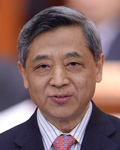|
 |
|
FRANK DISCUSSIONS: Xi Jinping (second from bottom), General Secretary of the Communist Party of China Central Committee, joins lawmakers from Jiangxi Province in a panel discussion concerning the Government Work Report during the annual session of the National People's Congress on March 6 in Beijing (XINHUA) |

Wang Junjin, NPC deputy, President of JuneYao Group
China's economic growth has entered a "new normal" and we should insist on deepening reform to promote sound development. A focus should be laid on accelerating the transformation of economic development model, promoting the mixed ownership economy, propelling state-owned enterprise (SOE) reforms, and providing more investment opportunities for private capital.
People need to know that the mixed-ownership reform will do a good job of invigorating the state-owned economy. Both state and private capital can create value for and make contributions to society.
Authorities should make plain the roadmap, methods and measures to promote the mixed-ownership economy. Over the course, efforts should be made to promulgate the responsibility system, set up the accountability system and ensure the consistency of policies.
SOEs should focus on their core business and cut down on subsidiary businesses that lie outside of their specialties, in order to elevate operational efficiency. They should go further in absorbing private capital, because new growth points will be found when combining the vitality of private enterprises with their resources.

Fan Xiaojian, CPPCC National Committee member, former Deputy Director of the Leading Group Office of Poverty Alleviation and Development with the State Council
China has only six years left to deliver its goal of establishing a moderately prosperous society by 2020. The realization of the goal is to a large extent dependent on how poverty relief is implemented in China.
Economic slowdown, combined with a large disparity in resident income, has added more difficulty to poverty relief. The Gini coefficient—a barometer of income disparity—for China increased to 0.47 in 2013 from 0.37 in 1994. Worse still, a slowdown in fiscal revenue has decreased the investment in poverty relief over the past two years. Growth in the poverty relief fund stood at 41 percent in 2011, it slowed to 32 percent in 2012 and further slipped to 24 percent in 2013. Therefore, under the economic "new normal," we should have a new plan for poverty relief.
China should take the lowering of the Gini coefficient and the narrowing of income gaps seriously. Poverty relief should be part of China's 13th Five-Year Plan (2016-20) to increase government support for the cause.
More funds should be earmarked for poverty relief, especially for providing public services such as infrastructure construction, education and medical care in poverty-stricken areas. Industrial transfer from coastal regions to inland cities should be seen as a good opportunity to develop local economies. Support for small and medium-sized enterprises in central and western regions should continuously be increased. Arrangements should be made for recipients of subsistence allowances, including their pensions. The priority should be given to the most urgent needs of the poorest strands of the population in the most poverty-stricken areas.

Feng Leping, NPC deputy, President of Beijing Federation of Farmers' Cooperatives
The "Four Compre-hensives" represent top-level design and strategic objectives for the country, which is widely anticipated by more than 6,000 members of the Beijing Federation of Farmers' Cooperatives.
On February 1, the CPC Central Committee and the State Council jointly released their first policy document for 2015, informally known as the "No.1 Document." Modern farming and rural reform are high on the agenda. Since 2004, issues concerning agriculture, rural areas and farmers have been the focus of central authorities' No.1 documents for 12 years in a row.
As a representative from the farming community, I think China's agricultural reform is heading toward agricultural modernization and transformation of the country's agricultural development model.
Reform in the agricultural sector should be more than just a structural change. It should be more of a change in the production and distribution model. Farmers that know nothing but plowing in the land can hardly take on this task. Therefore, the training of professional farmers should be strengthened, because they will be the main force of the agricultural sector in the future.

Mei Xingbao, CPPCC National Committee member, external supervisor at the Bank of China
The key to "comprehensively establishing a moderately prosperous society" lies in the broad coverage of the plan. Therefore, some industries should be allowed to gradually transfer from central and eastern regions to the western region. Also, a disparity between the growth rate in central and eastern regions and western region should be allowed.
The growth in the western region is slower than that in central and eastern regions, and western rural areas grow more slowly than urban areas. Accelerating the growth of the western region is a key issue. The western region's industrial layout should be adjusted to receive industrial transfer from central and eastern regions. In addition, the region can use the Silk Road Economic Belt initiative as an opportunity to realize the full capacity for development. Only when the western region prospers can the general goal be achieved.
Different growth rates should be tolerated when it comes to different regions: The eastern region should be allowed to grow at a rate lower than 7 percent while the western region should be allowed to develop more quickly.

Peng Xiaofeng, CPPCC National Committee member, Deputy Director of the Economic Committee of the 12th CPPCC National Committee
Establishing a moderately prosperous society requires the backup of steady economic growth. Last year, the Chinese economy grew 7.4 percent, a hard-won result as the country ruled out the possibility of rolling out massive stimulus package, improved the structure of industries, increased employment, maintained the CPI at a relatively low level and pushed forward reforms in an orderly manner.
Amid mounting downward pressure, the government work report lowered the growth target at around 7 percent. Although China has more toleration for slower growth, the country still needs to realize steady growth, which requires the market to play a key role in allocating resources. Steady growth will help facilitate the implementation of the "Four Comprehensives."
Email us at: yushujun@bjreview.com | 